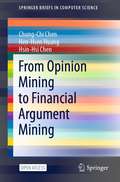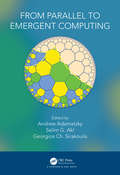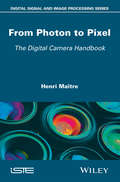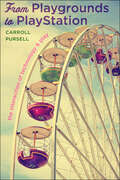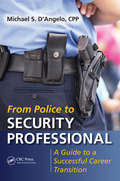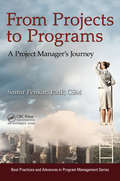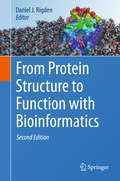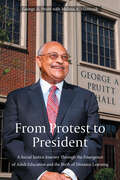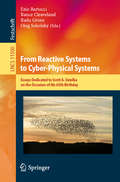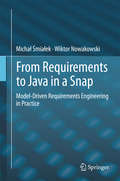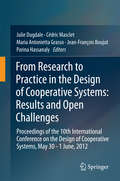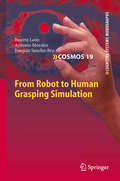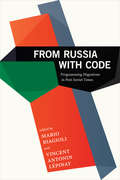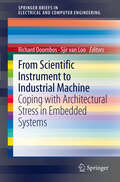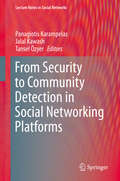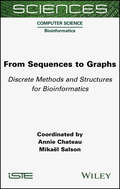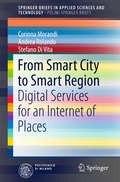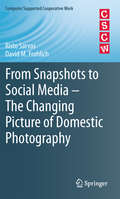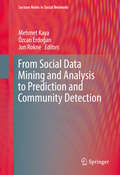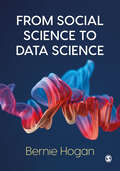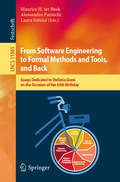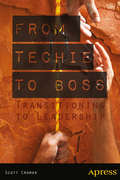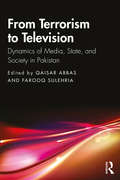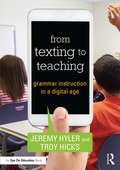- Table View
- List View
From Opinion Mining to Financial Argument Mining (SpringerBriefs in Computer Science)
by Chung-Chi Chen Hen-Hsen Huang Hsin-Hsi ChenOpinion mining is a prevalent research issue in many domains. In the financial domain, however, it is still in the early stages. Most of the researches on this topic only focus on the coarse-grained market sentiment analysis, i.e., 2-way classification for bullish/bearish. Thanks to the recent financial technology (FinTech) development, some interdisciplinary researchers start to involve in the in-depth analysis of investors' opinions. These works indicate the trend toward fine-grained opinion mining in the financial domain. When expressing opinions in finance, terms like bullish/bearish often spring to mind. However, the market sentiment of the financial instrument is just one type of opinion in the financial industry. Like other industries such as manufacturing and textiles, the financial industry also has a large number of products. Financial services are also a major business for many financial companies, especially in the context of the recent FinTech trend. For instance, many commercial banks focus on loans and credit cards. Although there are a variety of issues that could be explored in the financial domain, most researchers in the AI and NLP communities only focus on the market sentiment of the stock or foreign exchange. This open access book addresses several research issues that can broaden the research topics in the AI community. It also provides an overview of the status quo in fine-grained financial opinion mining to offer insights into the futures goals. For a better understanding of the past and the current research, it also discusses the components of financial opinions one-by-one with the related works and highlights some possible research avenues, providing a research agenda with both micro- and macro-views toward financial opinions.
From Parallel to Emergent Computing
by Georgios Sirakoulis Andrew Adamatzky Selim AklModern computing relies on future and emergent technologies which have been conceived via interaction between computer science, engineering, chemistry, physics and biology. This highly interdisciplinary book presents advances in the fields of parallel, distributed and emergent information processing and computation. The book represents major breakthroughs in parallel quantum protocols, elastic cloud servers, structural properties of interconnection networks, internet of things, morphogenetic collective systems, swarm intelligence and cellular automata, unconventionality in parallel computation, algorithmic information dynamics, localized DNA computation, graph-based cryptography, slime mold inspired nano-electronics and cytoskeleton computers. Features Truly interdisciplinary, spanning computer science, electronics, mathematics and biology Covers widely popular topics of future and emergent computing technologies, cloud computing, parallel computing, DNA computation, security and network analysis, cryptography, and theoretical computer science Provides unique chapters written by top experts in theoretical and applied computer science, information processing and engineering From Parallel to Emergent Computing provides a visionary statement on how computing will advance in the next 25 years and what new fields of science will be involved in computing engineering. This book is a valuable resource for computer scientists working today, and in years to come.
From Photon to Pixel
by Henri MaitreThe digital camera conceals remarkable technological innovations that affect the formation of the image, the color representation or automated measurements and settings. ** From photon to pixel photon ** describes the device both from the point of view of the physics of the phenomena involved, as technical components and software it uses. Based on the perceptual properties of the visual system as well as on standard transmission and representation, analyzes the solutions to meet the demands of the photographer on the development, contrast, white balance or stabilization of image. The advanced architectures adopted in mobile phones and developments of computational photography are also presented, foreshadowing the features of the future device.
From Playgrounds to PlayStation: The Interaction of Technology and Play
by Carroll PursellHow technology shapes play in America—and vice versa.In this romp through the changing landscape of nineteenth- and twentieth-century American toys, games, hobbies, and amusements, senior historian of technology Carroll Pursell poses a simple but interesting question: What can we learn by studying the relationship between technology and play? From Playgrounds to PlayStation explores how play reflects and drives the evolution of American culture. Pursell engagingly examines the ways in which technology affects play and play shapes people. The objects that children (and adults) play with and play on, along with their games and the hobbies they pursue, can reinforce but also challenge gender roles and cultural norms. Inventors—who often talk about "playing" at their work, as if motivated by the pure fun of invention—have used new materials and technologies to reshape sports and gameplay, sometimes even crafting new, extreme forms of recreation, but always responding to popular demand.Drawing from a range of sources, including scholarly monographs, patent records, newspapers, and popular and technical journals, the book covers numerous modes and sites of play. Pursell touches on the safety-conscious playground reform movement, the dazzling mechanical innovations that gave rise to commercial amusement parks, and the media's colorful promotion of toys, pastimes, and sporting events. Along the way, he shows readers how technology enables the forms, equipment, and devices of play to evolve constantly, both reflecting consumer choices and driving innovators and manufacturers to promote toys that involve entirely new kinds of play—from LEGOs and skateboards to beading kits and videogames.
From Police to Security Professional: A Guide to a Successful Career Transition
by Michael S. D'AngeloFormer police and military personnel possess attractive skill sets for the private security industry; however, the transition to the corporate arena is not without challenges. Competition for these jobs is fierce. Many candidates possess degrees in security management‘some having spent their entire professional careers in private security. From Police to Security Professional: A Guide to a Successful Career Transition provides tips on overcoming the inherent obstacles law enforcement professionals face in making the switch and supplies a practical roadmap for entry into the private security world.The foundation of the book comes from the author‘s own journey and the many hurdles he encountered transitioning to private sector security. With his help, you‘ll learn: The unique skills, experience, and mentality required to enter into the private security industry from a law enforcement background The opportunities available and the different areas within the industry including benefits and income potential How to properly evaluate your training portfolio How to tailor your resume to garner the attention of hiring executives The many professional associations and certifications that could be helpful in your career Vital to your ability to succeed is understanding that security management has evolved into a distinct profession in its own right one that brings with it different education, experience, and skill sets that clearly differentiate it from law enforcement. This book will help you better understand and be prepared for the policies, processes, and a corporate environment that operates in a very different way than the police structure to which you are accustomed.
From Projects to Programs: A Project Manager's Journey (Best Practices in Portfolio, Program, and Project Management #8)
by Samir PenkarThis book tells the story of an up-and-coming project manager that's been handed a large program to lead. Readers follow along as she struggles, leads, stumbles, and grows into the program manager role. Introducing key program management concepts throughout, the book provides a backstage view into the workings of program management, program organization, team dynamics, and the skills required to manage programs. Told through the eyes of a program manager, readers will experience the ins and outs of program management.
From Protein Structure to Function with Bioinformatics
by Daniel J. RigdenThis book is about protein structural bioinformatics and how it can help understand and predict protein function. It covers structure-based methods that can assign and explain protein function based on overall folds, characteristics of protein surfaces, occurrence of small 3D motifs, protein-protein interactions and on dynamic properties. Such methods help extract maximum value from new experimental structures, but can often be applied to protein models. The book also, therefore, provides comprehensive coverage of methods for predicting or inferring protein structure, covering all structural classes from globular proteins and their membrane-resident counterparts to amyloid structures and intrinsically disordered proteins. The book is split into two broad sections, the first covering methods to generate or infer protein structure, the second dealing with structure-based function annotation. Each chapter is written by world experts in the field. The first section covers methods ranging from traditional homology modelling and fold recognition to fragment-based ab initio methods, and includes a chapter, new for the second edition, on structure prediction using evolutionary covariance. Membrane proteins and intrinsically disordered proteins are each assigned chapters, while two new chapters deal with amyloid structures and means to predict modes of protein-protein interaction. The second section includes chapters covering functional diversity within protein folds and means to assign function based on surface properties and recurring motifs. Further chapters cover the key roles of protein dynamics in protein function and use of automated servers for function inference. The book concludes with two chapters covering case studies of structure prediction, based respectively on crystal structures and protein models, providing numerous examples of real-world usage of the methods mentioned previously. This book is targeted at postgraduate students and academic researchers. It is most obviously of interest to protein bioinformaticians and structural biologists, but should also serve as a guide to biologists more broadly by highlighting the insights that structural bioinformatics can provide into proteins of their interest.
From Protest to President: A Social Justice Journey through the Emergence of Adult Education and the Birth of Distance Learning
by George A PruittFrom Protest to President describes an inspirational odyssey of a young, Black activist coming of age in Mississippi and Chicago in the tumultuous 1960s and '70s, culminating in a notable thirty-five-year presidency at Thomas Edison State University. From barbershop encounters with Malcolm X to death threats at Illinois State University and gunfire at Towson State, Pruitt provides a powerful narrative poised at the intersection of social justice, higher education and politics. He recounts leadership experiences at HBCUs and public universities across the country, as he advocated for autonomy at Morgan State and fought to preserve Tennessee State University. His steadfast activism, integrity and courage led to groundbreaking work in providing access to higher education for working adults and the military. From his days as a student protester in high school and college to his appearances on Capitol Hill, Pruitt has earned the reputation as a candid and influential leader in higher education.
From Reactive Systems to Cyber-Physical Systems: Essays Dedicated to Scott A. Smolka on the Occasion of His 65th Birthday (Lecture Notes in Computer Science #11500)
by Ezio Bartocci Rance Cleaveland Radu Grosu Oleg SokolskyThis Festschrift is in honor of Scott A. Smolka, Professor in the Stony Brook University, USA, on the occasion of his 65th birthday. Scott A. Smolka made fundamental research contributions in a number of areas, including process algebra, model checking, probabilistic processes, runtime verification, and the modeling and analysis of cardiac cells, neural circuits and flocking behaviors. He is perhaps best known for the algorithm he and Paris Kanellakis invented for checking bi-simulation. The title of this volume From Reactive Systems to Cyber-Physical Systems reflects Scott's main research focus throughout his career. It contains the papers written by his closest friends and collaborators. The contributions cover a wide spectrum of the topics related to Scott's research scientific interests, including model repair for probabilistic systems, runtime verification, model checking, cardiac dynamics simulation and machine learning.
From Requirements to Java in a Snap
by Michał Śmiałek Wiktor NowakowskiThis book provides a coherent methodology for Model-Driven Requirements Engineering which stresses the systematic treatment of requirements within the realm of modelling and model transformations. The underlying basic assumption is that detailed requirements models are used as first-class artefacts playing a direct role in constructing software. To this end, the book presents the Requirements Specification Language (RSL) that allows precision and formality, which eventually permits automation of the process of turning requirements into a working system by applying model transformations and code generation to RSL. The book is structured in eight chapters. The first two chapters present the main concepts and give an introduction to requirements modelling in RSL. The next two chapters concentrate on presenting RSL in a formal way, suitable for automated processing. Subsequently, chapters 5 and 6 concentrate on model transformations with the emphasis on those involving RSL and UML. Finally, chapters 7 and 8 provide a summary in the form of a systematic methodology with a comprehensive case study. Presenting technical details of requirements modelling and model transformations for requirements, this book is of interest to researchers, graduate students and advanced practitioners from industry. While researchers will benefit from the latest results and possible research directions in MDRE, students and practitioners can exploit the presented information and practical techniques in several areas, including requirements engineering, architectural design, software language construction and model transformation. Together with a tool suite available online, the book supplies the reader with what it promises: the means to get from requirements to code "in a snap".
From Research to Practice in the Design of Cooperative Systems: Results and Open Challenges
by Parina Hassanaly Maria Antonietta Grasso Jean-François Boujut Cédric Masclet Julie DugdaleCOOP 2012 is the tenth COOP conference, marking twenty years from the first conference in 1992. In this special anniversary edition we asked researchers and practitioners to reflect on what have been the successes and the failures in designing cooperative systems, and what challenges still need to be addressed. We have come a long way in understanding the intricacies of cooperation and in designing systems that support work practices and collective activities. These advances would not have been possible without the concerted effort of contributions from a plethora of domains including CSCW, HCI, Information Systems, Knowledge Engineering, Multi-agent systems, organizational and management sciences, sociology, psychology, anthropology, ergonomics, linguistics, etc. The COOP community is going from strength to strength in developing new technologies, advancing and proposing new methodological approaches, and forging theories.
From Robot to Human Grasping Simulation
by Beatriz León Antonio Morales Joaquín Sancho-BruThe human hand and its dexterity in grasping and manipulating objects are some of the hallmarks of the human species. For years, anatomic and biomechanical studies have deepened the understanding of the human hand's functioning and, in parallel, the robotics community has been working on the design of robotic hands capable of manipulating objects with a performance similar to that of the human hand. However, although many researchers have partially studied various aspects, to date there has been no comprehensive characterization of the human hand's function for grasping and manipulation of everyday life objects. This monograph explores the hypothesis that the confluence of both scientific fields, the biomechanical study of the human hand and the analysis of robotic manipulation of objects, would greatly benefit and advance both disciplines through simulation. Therefore, in this book, the current knowledge of robotics and biomechanics guides the design and implementation of a simulation framework focused on manipulation interactions that allows the study of the grasp through simulation. As a result, a valuable framework for the study of the grasp, with relevant applications in several fields such as robotics, biomechanics, ergonomics, rehabilitation and medicine, has been made available to these communities.
From Russia with Code: Programming Migrations in Post-Soviet Times
by Mario Biagioli Vincent Antonin LépinayWhile Russian computer scientists are notorious for their interference in the 2016 US presidential election, they are ubiquitous on Wall Street and coveted by international IT firms and often perceive themselves as the present manifestation of the past glory of Soviet scientific prowess. Drawing on over three hundred in-depth interviews, the contributors to From Russia with Code trace the practices, education, careers, networks, migrations, and lives of Russian IT professionals at home and abroad, showing how they function as key figures in the tense political and ideological environment of technological innovation in post-Soviet Russia. Among other topics, they analyze coders' creation of both transnational communities and local networks of political activists; Moscow's use of IT funding to control peripheral regions; brain drain and the experiences of coders living abroad in the United Kingdom, United States, Israel, and Finland; and the possible meanings of Russian computing systems in a heterogeneous nation and industry. Highlighting the centrality of computer scientists to post-Soviet economic mobilization in Russia, the contributors offer new insights into the difficulties through which a new entrepreneurial culture emerges in a rapidly changing world. Contributors. Irina Antoschyuk, Mario Biagioli, Ksenia Ermoshina, Marina Fedorova, Andrey Indukaev, Alina Kontareva, Diana Kurkovsky, Vincent Lépinay, Alexandra Masalskaya, Daria Savchenko, Liubava Shatokhina, Alexandra Simonova, Ksenia Tatarchenko, Zinaida Vasilyeva, Dimitrii Zhikharevich
From scientific instrument to industrial machine
by Sjir Van Loo Richard DoornbosArchitectural stress is the inability of a system design to respond to new market demands. It is an important yet often concealed issue in high tech systems. In From scientific instrument to industrial machine, we look at the phenomenon of architectural stress in embedded systems in the context of a transmission electron microscope system built by FEI Company. Traditionally, transmission electron microscopes are manually operated scientific instruments, but they also have enormous potential for use in industrial applications. However, this new market has quite different characteristics. There are strong demands for cost-effective analysis, accurate and precise measurements, and ease-of-use. These demands can be translated into new system qualities, e.g. reliability, predictability and high throughput, as well as new functions, e.g. automation of electron microscopic analyses, automated focusing and positioning functions. From scientific instrument to industrial machine takes a pragmatic approach to the problem of architectural stress. In particular, it describes the outcomes of the Condor project, a joint endeavour by a consortium of industrial and academic partners. In this collaboration an integrated approach was essential to successfully combine various scientific results and show the first steps towards a new direction. System modelling and prototyping were the key techniques to develop better understanding and innovative solutions to the problems associated with architectural stress. From scientific instruments to industrial machine is targeted mainly at industrial practitioners, in particular system architects and engineers working on high tech systems. It can therefore be read without particular knowledge of electron microscope systems or microscopic applications. The book forms a bridge between academic and applied science, and high tech industrial practice. By showing the approaches and solutions developed for the electron microscope, it is hoped that system designers will gain some insights in how to deal with architectural stress in similar challenges in the high tech industry.
From Security to Community Detection in Social Networking Platforms (Lecture Notes in Social Networks)
by Jalal Kawash Panagiotis Karampelas Tansel ÖzyerThis book focuses on novel and state-of-the-art scientific work in the area of detection and prediction techniques using information found generally in graphs and particularly in social networks. Community detection techniques are presented in diverse contexts and for different applications while prediction methods for structured and unstructured data are applied to a variety of fields such as financial systems, security forums, and social networks. The rest of the book focuses on graph-based techniques for data analysis such as graph clustering and edge sampling. The research presented in this volume was selected based on solid reviews from the IEEE/ACM International Conference on Advances in Social Networks, Analysis, and Mining (ASONAM '17). Chapters were then improved and extended substantially, and the final versions were rigorously reviewed and revised to meet the series standards. This book will appeal to practitioners, researchers and students in the field.
From Sequences to Graphs: Discrete Methods and Structures for Bioinformatics
by Annie Chateau Mikaël SalsonIn order to study living organisms, scientists not only study them at an overall macroscopic scale but also on a more detailed microscopic scale. This observation, pushed to its limits, consists of investigating the very center of each cell, where we find the molecules that determine the way it functions: DNA (deoxyribonucleic acid) and RNA (ribonucleic acid). In an organism, DNA carries the genetic information, which is called the genome. It is represented as four-letter sequences using the letters A, C, G and T; based on these sequences, computer methods described in this book can answer fundamental questions in bioinformatics. This book explores how to quickly find sequences of a few hundred nucleotides within a genome that may be made up of several billion, how to compare those sequences and how to reconstruct the complete sequence of a genome. It also discusses the problems of identifying bacteria in a given environment and predicting the structure of RNA based on its sequence.
From Smart City to Smart Region
by Corinna Morandi Andrea Rolando Stefano Di VitaThis book offers a fascinating exploration of the relationship between information and communication technologies (ICTs) and spatial planning, expanding the concept of "urban smartness" from the usual scale of buildings or urban projects to the regional dimension. In particular, it presents the outcomes of research undertaken at Politecnico di Milano, in collaboration with Telecom Italia, that had three principal goals: to investigate the use of ICTs for the representation, promotion, management, and dissemination of an integrated system of services; to explore the spatial impacts of digital services at different scales (regional, urban, local); and to understand how a system of mobile services can encourage new spatial uses and new collective behavior in the quest for better spatial quality of places. Useful critical analysis of international case studies is also included with the aim of verifying the opportunities afforded by new digital services not only to improve the urban efficiency but also to foster the evolution of urban communities through enhancement of the public realm. The book will be a source of valuable insights for both scholars and local administrators and operators involved in smart city projects.
From Snapshots to Social Media - The Changing Picture of Domestic Photography
by Risto Sarvas David M. FrohlichFrom Snapshots to Social Media describes the history and future of domestic photography as mediated by technological change. Domestic photography refers to the culture of ordinary people capturing, sharing and using photographs, and is in a particular state of flux today as photos go digital. The book argues that this digital era is the third major chapter in the 170 year history of the area; following the portrait and Kodak eras of the past. History shows that despite huge changes in photographic technology and the way it has been sold, people continue to use photographs to improve memory, support communication and reinforce identity. The future will involve a shift in the balance of these core activities and a replacement of the family album with various multimedia archives for individuals, families and communities. This raises a number of issues that should be taken into account when designing new technologies and business services in this area, including: the ownership and privacy of content, multimedia standards, home ICT infrastructure, and younger and older users of images. The book is a must for designers and engineers of imaging technology and social media who want a better understanding of the history of domestic photography in order to shape its future. It will also be of value to students and researchers in science and technology studies and visual culture, as a fascinating case study of the evolving use of photographs and photographic technology in Western society.
From Social Data Mining and Analysis to Prediction and Community Detection
by Mehmet Kaya Özcan Erdoǧan Jon RokneThis book presents the state-of-the-art in various aspects of analysis and mining of online social networks. Within the broader context of online social networks, it focuses on important and upcoming topics of social network analysis and mining such as the latest in sentiment trends research and a variety of techniques for community detection and analysis. The book collects chapters that are expanded versions of the best papers presented at the IEEE/ACM International Conference on Advances in Social Networks Analysis and Mining (ASONAM'2015), which was held in Paris, France in August 2015. All papers have been peer reviewed and checked carefully for overlap with the literature. The book will appeal to students and researchers in social network analysis/mining and machine learning.
From Social Science to Data Science: Key Data Collection and Analysis Skills in Python
by Bernie HoganFrom Social Science to Data Science is a fundamental guide to scaling up and advancing your programming skills in Python. From beginning to end, this book will enable you to understand merging, accessing, cleaning and interpreting data whilst gaining a deeper understanding into computational techniques and seeing the bigger picture. With key features such as tables, figures, step-by-step instruction and explanations giving a wider context, Hogan presents a clear and concise analysis on key data collection and skills in Python.
From Social Science to Data Science: Key Data Collection and Analysis Skills in Python
by Bernie HoganFrom Social Science to Data Science is a fundamental guide to scaling up and advancing your programming skills in Python. From beginning to end, this book will enable you to understand merging, accessing, cleaning and interpreting data whilst gaining a deeper understanding into computational techniques and seeing the bigger picture. With key features such as tables, figures, step-by-step instruction and explanations giving a wider context, Hogan presents a clear and concise analysis on key data collection and skills in Python.
From Software Engineering to Formal Methods and Tools, and Back: Essays Dedicated to Stefania Gnesi on the Occasion of Her 65th Birthday (Lecture Notes in Computer Science #11865)
by Maurice H. ter Beek Alessandro Fantechi Laura SeminiThis volume was published in honor of Stefania Gnesi’s 65th birthday. The Festschrift volume contains 32 papers written by close collaborators and friends of Stefania and was presented to her on October 8, 2019 one-day colloquium held in Porto, Portugal, The Festschrift consists of eight sections, seven of which reflect the main research areas to which Stefania has contributed. Following a survey of Stefania's legacy in research and a homage by her thesis supervisor, these seven sections are ordered according to Stefania's life cycle in research, from software engineering to formal methods and tools, and back: Software Engineering; Formal Methods and Tools; Requirements Engineering; Natural Language Processing; Software Product Lines; Formal Verification; and Applications.
From Techie to Boss: Transitioning to Leadership
by David Jacobs Scott CromarFrom Techie to Boss teaches technical people who are making or mulling the transition from team player to team leader all the management techniques and soft leadership skills they never needed before-but need now, pronto. Veteran team lead and project manager Scott Cromar lays out the classical management training course, but stripped down to precisely the essentials that techies need to start managing on the fly. He gets it that a front-line techie getting a field promotion to team leader just doesn't have the time to wade through an MBA textbook bulging with irrelevant material. The author appreciates how you got to the place where you need this book. Management tapped you instead of some experienced manager from the outside because you know the technical challenges, company culture, and team players better than anyone else: you're ready to hit the ground running. But the skills that make you an excellent techie are not sufficient to make you a successful manager. The rules of your world have abruptly changed. You will now be judged not by your puzzle-solving elegance but by how effectively your team contributes to the organization's bottom line. From Techie to Boss shows you how to translate and adapt the analytic skills that made you an outstanding techie to your new responsibilities as a technical manager. Even more crucially, this book teaches you a whole new set of interpersonal, organizational, and metrical skills you never needed before, but without which you cannot succeed as a manager.
From Terrorism to Television: Dynamics of Media, State, and Society in Pakistan
by Qaisar AbbasThis book unpacks the media dynamics within the socio-cultural, political, and economic context of Pakistan. It provides an in-depth, critical, and scholarly discussion of contemporary issues such as media, state, and democracy in Pakistan; freedom of expression in Pakistani journalism; Balochistan as a blind spot in mainstream newspapers; media control by state institutions; women and media discourses; TV talk shows and coverage of Kashmir; feminist narrative and media images of Malala Yousufzai and Mukhtaran Mai; jihad on screen; and Osama bin Laden’s death on screen, to understand the relation between media and terrorism. The book covers diverse media types including TV, radio, newspapers, print media, films, documentary, stage performance, and social media. Detailed, interdisciplinary, analytical, and with original perspectives from journalists as well as academics, this volume will be useful to scholars and researchers of media studies, Pakistan studies, politics and international affairs, military and terrorism studies, journalism and communication studies, and South Asian studies. It will also interest general readers, policy makers, and those interested in global journalism, mass media, and freedom of expression.
From Texting to Teaching: Grammar Instruction in a Digital Age
by Jeremy Hyler Troy HicksDon’t blame technology for poor student grammar; instead, use technology intentionally to reach students and actually improve their writing! In this practical book, bestselling authors Jeremy Hyler and Troy Hicks reveal how digital tools and social media – a natural part of students’ lives – can make grammar instruction more authentic, relevant, and effective in today’s world. Topics Covered: Teaching students to code switch and differentiate between formal and informal sentence styles Using flipped lessons to teach the parts of speech and help students build their own grammar guides Enlivening vocabulary instruction with student-produced video Helping students master capitalization and punctuation in different digital contexts Each chapter contains examples, screenshots, and instructions to help you implement the ideas. With the strategies in this book, you can empower students to become better writers with the tools they already love and use daily. Additional resources and links are available on the book’s companion wiki site: textingtoteaching.wikispaces.com
